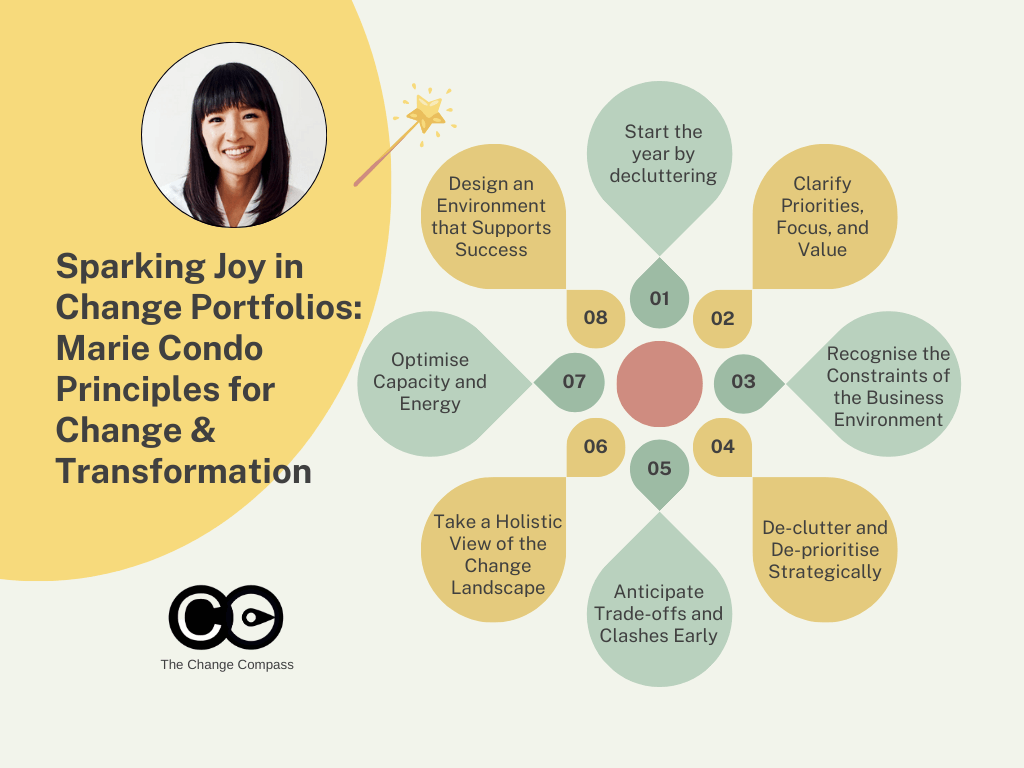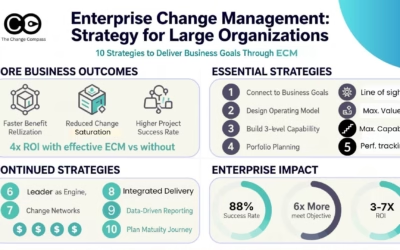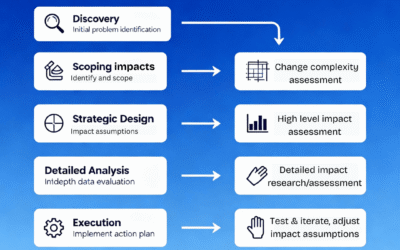As the new year begins, it’s a natural time to reflect, refocus, and set the stage for success. For senior change and transformation professionals, this is an opportune moment to assess the upcoming portfolio of initiatives. Taking inspiration from Marie Kondo’s principles of decluttering and creating joy, we can apply these ideas to optimise our change portfolios and ensure they are designed for impact, sustainability, and value.
1. Start the Year by Decluttering
Just as Marie Kondo advises starting with a clean slate by letting go of unnecessary items, the new year offers the perfect chance to reassess the change portfolio. Decluttering is not just about removing excess; it’s about making deliberate, strategic decisions to create space for what truly matters. Many organisations find themselves burdened by legacy projects, overlapping initiatives, and unnecessary complexity. These elements consume valuable resources and dilute focus, ultimately jeopardising the success of the portfolio as a whole.
To start the decluttering process, take time to systematically review all initiatives. Begin by cataloging everything currently in progress or planned for the upcoming year. This exercise will reveal the true scope of commitments and help identify initiatives that may no longer align with the organisation’s strategic priorities. From there, engage with key stakeholders to challenge assumptions and uncover opportunities to streamline. By proactively identifying what can be paused, combined, or retired, you free up capacity for the initiatives that deliver the greatest value.
Your next PI (Program Increment) Planning will be a great opportunity to do this. As you work with other teams to assess scheduling and alignment, use this opportunity to align with stakeholder to cull and re-prioritise as required. It may be a good idea to do this prior to the PI Planning session to ensure the session is tight and focused.
Decluttering is not just about removing initiatives; it’s about creating space for the initiatives that truly matter. This exercise can involve:
- Conducting a Portfolio Audit: List all current and planned initiatives. Categorize them by strategic importance, urgency, and expected impact.
- Engaging Stakeholders: Facilitate discussions with leaders and project owners to challenge the status quo. Ask critical questions: Does this initiative serve a pressing need? Can its objectives be achieved through another project?
- Identifying Redundancies: Often, multiple initiatives address overlapping goals. Combining efforts can streamline resources and improve focus.
2. Clarify Priorities, Focus, and Value
One of the key principles of joyful organisation is clarity. In the context of change management, clarity means ensuring that every initiative in the portfolio has a clearly defined purpose, aligns with organizational priorities, and delivers measurable value. Without this clarity, portfolios risk becoming overcrowded and unfocused, leading to wasted resources and frustrated teams.
Take a step back to evaluate each initiative against the organisation’s strategic goals. This process should involve critical questions such as: Does this initiative support our long-term vision? What specific problems does it solve? How does it fit into the broader transformation journey? Answering these questions will help identify initiatives that lack focus or fail to deliver meaningful value.
Clarity also requires a shared understanding across the organisation. Leaders, teams, and stakeholders must be aligned on what matters most. Misaligned priorities can lead to confusion, duplication of efforts, and competing demands on resources. By fostering open communication and establishing clear criteria for decision-making, you can ensure that everyone is working toward the same goals.
Creating clarity requires tools and structured processes:
- Use Priority Matrices: Tools like the Eisenhower Matrix or impact-effort grids can help categorise initiatives based on their urgency and value. To read more about the Eisenhower Matrix visit this Forbes article
- Define Metrics of Success: For each initiative, identify clear KPIs that demonstrate its contribution to the organisation’s goals. This helps maintain focus and provides a benchmark for future evaluations.
- Communicate Priorities Clearly: Ensure that leadership and teams are aligned on what matters most. A shared understanding of priorities reduces the risk of misaligned efforts.
3. Recognise the Constraints of the Business Environment
Unlike a personal decluttering exercise, most organisations cannot afford to focus on just a few initiatives due to the fast-paced and ever-changing nature of the business world. New market demands, technological advancements, and regulatory changes often force organisations to pivot or expand their priorities mid-year. This makes it critical to design a change landscape that can accommodate both planned and emergent needs.
A well-structured portfolio balances transformational initiatives with business-as-usual (BAU) activities, ensuring that both long-term and short-term goals are addressed. However, achieving this balance requires careful planning and the ability to adapt. Organisations must be prepared to reassess priorities and make adjustments without derailing progress.
Designing the change landscape involves creating a comprehensive view of all initiatives, their interdependencies, and their impact on resources. This view should be regularly updated to reflect changes in the business environment. Scenario planning can also be invaluable, allowing organisations to explore potential outcomes and identify strategies for adapting to new challenges.
The optimal change landscape for your impacted stakeholders is one that is not cluttered, but one that is tight, focused and considered. It is not just about avoiding change saturation. It is about designing the right energy, focus, momentum and capacity.
Designing the change landscape involves:
- Mapping the Portfolio: Visualise all initiatives, their timelines, and dependencies. Tools like Gantt charts or Kanban boards can help create a comprehensive view
- Scenario Planning: Consider different scenarios based on potential changes in the business environment. How will the portfolio adapt if priorities shift mid-year?
- Building Flexibility: Design the portfolio to accommodate adjustments without derailing progress. This might mean reserving resources for unforeseen priorities or having contingency plans for high-risk initiatives.
To do all these can be taxing. Check out The Change Compass for a view of your initiative impacts on people in terms of capacity and involvement. It also allows you to design and visualise different scenarios of different initiative sequences. You can easily see the forecasted capacity of various teams and be able to leverage AI insights on key risks.

4. De-clutter and De-prioritise Strategically
It’s common for certain initiatives to linger in the portfolio simply because they are pet projects of influential leaders. While these may have merit, it’s essential to make deliberate choices about what stays and what goes. Without these hard decisions, portfolios can become bloated, stretching resources too thin and compromising the success of high-priority initiatives.
Facilitating open conversations with stakeholders is key to successful de-prioritisation. This requires a combination of diplomacy and data-driven insights. By presenting clear evidence of an initiative’s impact (or lack thereof), you can shift the conversation from emotion to evidence. It’s also important to address the organisational culture around failure and closure. Retiring an initiative should be seen as a strategic decision rather than a failure.
Strategies for effective de-prioritization include:
- Data-Driven Decision Making: Use data to demonstrate the potential ROI of each initiative. This helps shift conversations from emotion to evidence.
- Transparent Communication: Be honest about why certain initiatives are being deprioritised. Transparency builds trust and reduces resistance.
- Celebrate Closure: For initiatives that are retired, acknowledge the effort invested and celebrate the learnings. This reinforces a culture of continuous improvement.
5. Anticipate Trade-offs and Clashes Early
One of the most common pitfalls in change management is waiting until conflicts arise before addressing them. Portfolio clashes, resource shortages, and stakeholder fatigue can often be predicted well in advance. However, many organisations fail to have the necessary conversations early enough, leading to last-minute crises that disrupt progress. Having conversations too late means your initiative stakeholders are already invested given the significant effort and resources put in. This means it makes it even harder to change committed timelines, even when there are significant risks.
Proactively anticipating trade-offs requires a combination of foresight, tools, and collaborative discussions. Change impact assessments, capacity planning, and regular portfolio reviews are invaluable in identifying potential bottlenecks and saturation points. Additionally, creating forums for open dialogue allows stakeholders to surface concerns and explore solutions before issues escalate.
By anticipating challenges ahead of time, you create a smoother path for change initiatives to succeed. Key practices include:
- Regular Portfolio Reviews: Establish a cadence for reviewing the portfolio. These reviews should assess progress, identify emerging risks, and recalibrate priorities as needed.
- Engaging Cross-Functional Teams: Include representatives from impacted teams in decision-making. Their insights can help identify potential clashes that might be overlooked.
- Scenario Analysis: Model different scenarios to understand how changes in one initiative might ripple across the portfolio. This foresight enables proactive adjustments.
6. Take a Holistic View of the Change Landscape
Change portfolios often focus on big-ticket initiatives, but employees experience all changes—big or small—as part of the same landscape. Every new tool, process, or initiative adds to the cognitive and emotional load of employees. Failing to account for this cumulative impact can lead to burnout, disengagement, and resistance to change.
Taking a holistic view means looking beyond the high-profile initiatives to include BAU initiatives, operational changes, and even cultural events like town halls or roadshows. All these elements compete for employees’ time and energy. By considering the full scope of activities, you can create a more realistic and empathetic plan that supports employee well-being.
Everything that takes time, focus, or mental energy should be part of the portfolio view. This holistic approach ensures realistic planning and reduces the risk of burnout. Practical steps include:
- Creating a Change Calendar: Map all change-related activities, including BAU tasks and cultural events, to understand their cumulative impact on employees.
- Conducting Employee Impact Assessments: Gather feedback from employees to understand how various initiatives affect their workload and well-being.
- Prioritizing Communication: Ensure employees have a clear understanding of what’s coming and how it fits into the broader organisational goals.
7. Optimise Capacity and Energy
While most portfolios focus on deliverables, the real enabler of success is the energy and capacity of those who drive and experience change. Key considerations include:
- Assessing the available capacity in impacted teams.
- Designing sequences of change that maximize energy levels (e.g., scheduling major initiatives after quieter periods).
- Factoring in recovery time after high-stress periods or significant releases.
By aligning the portfolio to the energy rhythms of the organisation, you increase the likelihood of successful adoption and sustained change. Specific strategies include:
- Workload Balancing: Ensure no team or individual is overburdened. Distribute responsibilities equitably and provide support where needed.
- Energy Mapping: Identify periods of high energy and focus within the organisation. Schedule demanding initiatives during these times to maximise success.
- Encouraging Breaks: Build in time for reflection and recovery. Whether it’s a pause after a major release or regular team check-ins, these moments are crucial for maintaining momentum.

8. Design an Environment that Supports Success
Finally, creating the right environment for change is essential. Just as Marie Kondo encourages designing spaces that spark joy, change professionals should design portfolios that:
- Foster collaboration and open communication.
- Provide the necessary tools, resources, and support for employees.
- Build a culture of adaptability and resilience.
- ‘Joy’ for the organisation is one that is balanced with achieving business objects and optimal people experience during change and transformation
A well-designed change environment creates the conditions for initiatives to thrive and for employees to embrace new ways of working. Consider:
- Investing in Change Capability: Provide training and resources to build change management skills across the organisation.
- Creating Feedback Loops: Establish mechanisms for continuous feedback and improvement. This ensures the portfolio remains aligned with evolving needs.
- Celebrating Successes: Recognise and reward achievements, both big and small. Celebrating progress reinforces a positive change culture.
Applying Marie Kondo’s principles to change portfolio management allows organisations to focus on what truly matters, let go of what doesn’t, and create a change landscape that sparks energy and engagement. By decluttering, prioritising, and designing for capacity, senior change professionals can position their organisations for success in the year ahead. Take this opportunity to curate a portfolio that not only drives transformation but also brings clarity, purpose, and joy to the journey.
Remember, a well-organised change portfolio is not just about achieving organisational goals—it’s about creating an environment where people thrive, adapt, and contribute their best. Let this be the year your change portfolio truly sparks joy.
To read more about managing a change portfolio, check out our other articles.






